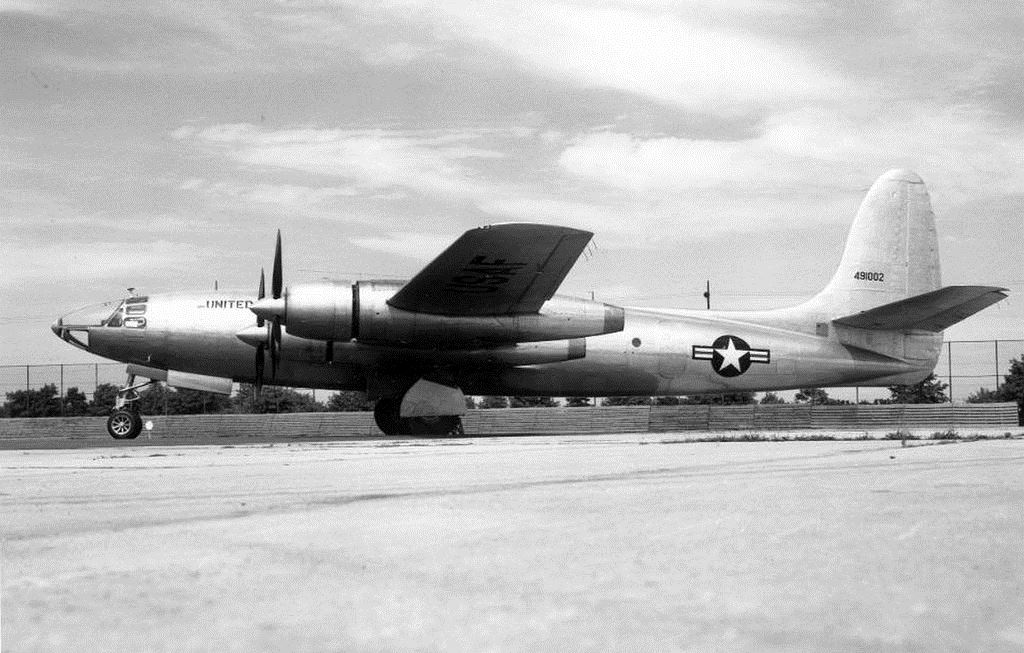Timing Again
XF-12 002 was damaged during an attempted max weight landing on 10 July 1947. After losing the starboard landing gear during an awkward attempt at a “landing,” the pilot was able to coax the airplane back into the air.
After burning off as much fuel as possible, the aircraft landed on the port and nose gear. When the starboard wing inevitably did contact the ground, the wing spar was cracked, and the engines and props needed replacement. Republic repaired 002.
Externally, the two prototypes differed only in the upper engine cowling configurations, with 003 having additional cooling vents. However, XR-12 003 was, as the second prototype, fully equipped with the mission-specific equipment.
By the time Operation Birds Eye concluded, the Air Force had cancelled the XF-12 program. Though neither was anywhere near as capable, the B-29 and B-50 were available, and the B-47 was in the pipeline. The same, unfortunately, could be said about a civilian airliner version of the Rainbow.

Take the Express
The Republic RC-2 was intended to be the civilian airliner version of the XR-12. Differences between the XR-12 and RC-2 included a revised cockpit and nose section of conventional design, a five-foot plug added ahead of the wing, increased fuel capacity, more powerful versions of the R-4360 Wasp Major engines with a single turbocharger each, additional windows and access, and the requisite appointments found aboard contemporary airliners of the day- but again, with considerably better performance than anything else in the sky.
Up to 46 passengers (with a crew of seven) would be rushed in plush comfort from A to B, zipping along at 435 miles per hour at 40,000 feet aboard the RC-2. But once again, timing was not in Republic’s favor.
Other available designs with higher passenger capacity, such as the Lockheed Constellation and the Douglas DC-6, were less capable but also already well on their way to being, or already were, in service. American Airlines and Pan American were interested, even going so far as to execute initial purchase orders. However, without an Air Force contract for the XR-12, their purchases never materialized- nor did the RC-2.

Sad Endings
On 7 November 1948, XR-12 003 crashed into Choctawhatchee Bay near Eglin AFB in Florida after the number two engine exploded inflight. Two of the crew of seven aboard for the photographic suitability test flight perished in the crash. XR-12 002 had been repaired and returned to service earlier in 1948 after its landing mishap and continued test and research flights.
However, even those, though still impressive, gradually decreased until the aircraft was retired in June 1952. Stricken from the inventory by the Air Force, 002 met her ignominious end at Aberdeen Proving Ground as (heavy sigh), a target.

The What If
It’s been said that had the XF-12 been developed just a year or two earlier, the Air Force would have bought in. Had that happened, history would look upon the Rainbow as an unparalleled engineering triumph, and the trajectory of four-engine aircraft design might have been substantially altered.
So were Kartveli and his design team ahead of their time or behind it?
Aviation history is full of advanced designs that were victims of timing or limitations in available engine technology. Witness the McDonnell XP-67 Moonbat, the Lockheed XF-90 penetration fighter, the Consolidated XB-46 bomber, the Vought F7U Cutlass, and the McDonnell F3H Demon, to name just a few. Others, like the Douglas A3D Skywarrior, overcame initial engine problems and went on to long careers.

Rainbow Trivia
Instead of equipping the XF-12 with standard cowl flaps (which, of course, caused drag when open), Republic designers implemented a sliding cowl design. When slid to the open position, engine cooling air exited the openings located near the engine firewalls. When closed, engine cooling air was ducted through to the exhaust at the rear of the nacelle—actually producing a net thrust gain.
The exhaust from the engines was also ducted straight out of the back of the nacelles. This provided additional thrust—up to 250 horsepower per engine—during high-speed, high-altitude cruises.

Speaking of those nacelles, each one was as long as that most famous of Republic aircraft (at the time), the P-47 Thunderbolt.
As originally designed, the XF-12 was to be equipped with contra-rotating propellers (twin three-bladed configuration). However, when complexity and reliability issues cropped up during engine-propeller combination evaluation, it was decided that the 16-foot conventional Curtiss four-blade propellers would do the job.
In May 1946, XF-12 002 set a new cross-country speed record for four-engine aircraft. The Rainbow shattered the previous record, held by a Lockheed Constellation, covering 576 miles between New York and Wright Field at 426 miles per hour- 51 miles per hour faster than the Connie.
Author’s note: Regarding the F vs. R designation, I referred to the Rainbow as the XF-12 prior to 1948 and as the XR-12 thereafter. Yes, it might be confusing, but it’s accurate. Also, my grandfather worked in supply and logistics at Republic Aviation during the war. He owned an RC-3 Seabee and watched the Rainbow take its unmistakable shape. He always referred to it as the most beautiful aircraft he had ever seen.

A very nice article, informative and well written. It’s not just about the airplane, but of mankind’s ability to create such inspiring machines.
It was a beautiful airplane. Just arrived at the wrong time.